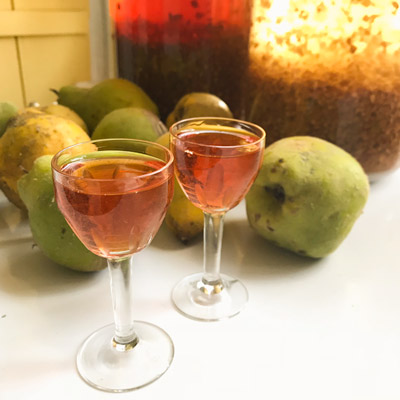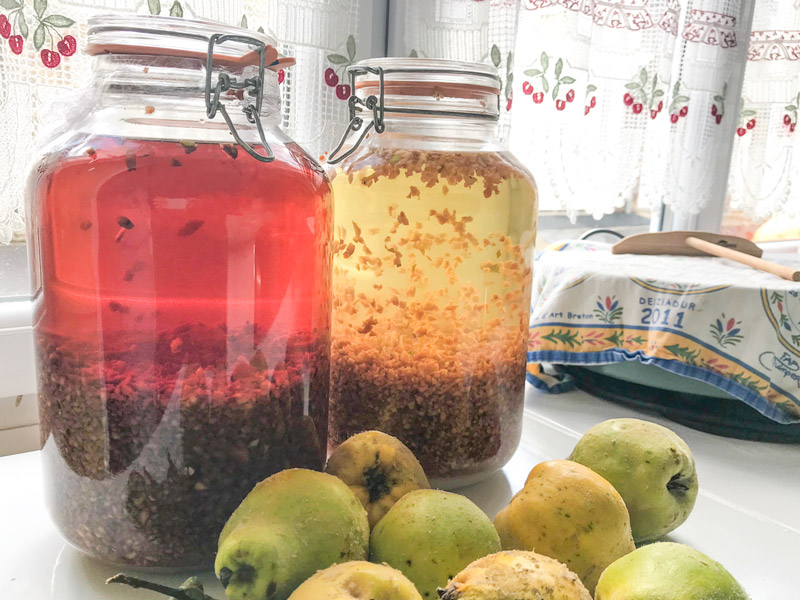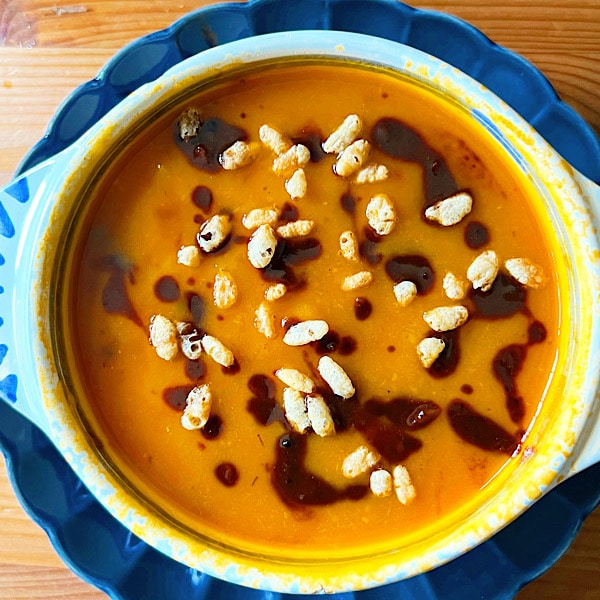
Quince can be a tough sell. Peeling quince (a very firm, sweet-smelling fruit that looks like a cross between an apple and a pear) is wrist-aching work, cutting it open is akin to splitting a winter squash, and seeding it is harder than any apple or pear you’d ever have to seed. Plus, the sour, grainy-fleshed fruit needs to be cooked (usually with a fair amount of sweetener) to be edible at all. Of course, quince is its own sweet reward if you love its extraordinary honey-apple-pear fragrance and flavor as I do. (The scent is so divine that Parisian candlemaker Diptyque has a quince (coing) candle.) So, after many years of sore wrists (peeling), sliced fingers (chopping) and finding tough little bits still left on the prepared fruit (seeding), I’ve devised some major shortcuts that make cooking with quince really easy.
The best shortcut I can think of—and the best introduction to quince for those who have never prepared it before—is to use it to make cordials. I have been making a quince cordial by macerating quince in brandy for many years now, and each year, I seem to need to make a little more because I keep finding uses for it. It is lovely to sip on before or after dinner (natch), but it can also be used to flavor desserts and make cocktails (quince kir royal is a winner).
I’ve always just eyeballed the quantities of fruit, sugar, and brandy I used to make quince cordial because that was how I first learned to make it. I shudder when I think of that recipe now, because it called for peeling, seeding and dicing the quince before macerating it with the brandy and sugar. I’ve done away with all that so the prep time is now a matter of minutes rather than hours. I’ve given amounts for a single bottle of cordial, but you can increase the quantities according to how much quince you have and how much liqueur you want to make/store.

Quince Cordial/Quince Brandy
½ lb./250 g quince, about 1 large fruit
¼ cup/60 g sugar
1 quart/1 liter inexpensive brandy, Cognac or Armagnac
Scrub the quince (don’t just rinse it) to remove any fuzz on the skin. Cut the quince into quarters, then put them skin, seeds, and all in a food processor. Pulse the quince until finely chopped. (If you don’t have a food processor, just thinly slice the quince quarters.)
Transfer the chopped quince to a 2-quart glass jar. Add the sugar, then pour the brandy over top. Close the lid tightly overtop, shake to distribute the sugar, then leave to macerate on a sunny counter or windowsill for a month to six weeks—the sun’s warmth will help the quince release its flavors, kind of like making sun tea without cooking or spoiling the cordial.
Strain the cordial through a fine-meshed strainer, then transfer to a 1 quart bottle. Discard the fruit, or reuse it to make quince jelly. Store the cordial in a cool, dark place. Serve in small port or cordial glasses or use to flavor desserts (2 Tbs. to ¼ cup per recipe) and make cocktails.
Quince Ratafia
This year, I’m trying out a new recipe: quince wine, aka quince ratafia. (Little etymological note here: ‘Ratafia!’ was a raise-your-glass toast in 17th century France which basically meant a deal was sealed.) The process for making ratafia is the same as for quince cordial, only it calls for white wine and more sugar and yields a beverage that is more of a cocktail than an after dinner drink.
1 3/4 lb./750 g. quince (3 or 4 large fruit)
1 ½ cups/300 g sugar
1 ½ cups/300 ml grain alcohol or vodka
3 bottles white wine
Scrub the quince to remove any fuzz on the skin. Cut the quince into quarters, then put them skin, seeds, and all in a food processor. Pulse the quince until finely chopped. (If you don’t have a food processor, just thinly slice the quince quarters.)
Transfer the quince to a 1-gallon glass jar with a tight-fitting lid. Add the sugar, alcohol and wine, and close tightly. Leave to macerate in a cool, dark place for 1 month to 6 weeks
Strain the ratafia through a fine-meshed strainer, then transfer to bottles. Store in a cool, dark place. Serve chilled.



Hi, I’ve just discovered your site – searching for my husband and son in law. Very interested
In making some Of your Quince Brandy (as soon as I can source a few quince and also I’d like to then use The left over Pulp for some Quince Jam or Jelly – do you have a Preferred Recipe?
Cheers, Karen
Hi Karen, So glad you’re interested in making quince brandy. It is truly luscious – I’ve been using it to make « quince cosmopolitans » recently! For the jelly, I have a whole post on this site. I highly recommend jelly because it’s so easy…the jam also tends to be an acquired taste because it can be so thick and has a grainy texture. Let me know how it goes!
Bonjour, Mon ami!
This sounds delicious. Just made a quarter batch of the brandy…can’t wait. I have an old quince bush that yields small, hard green quinces and used demerara because the flavour seems right. Thanks for the idea… I’m already imagining drinking this round Christmas!
Oooh…I hope you love it as much as I do! It’s about time for me to make another (big) batch, too. I’m very jealous of your quince bush! Cheers!
I know this was an older post, but I’m curious if you ever roasted the shredded quince a little to bring out some of the cooked flavor?
I’ve never roasted the quince – it’s already enough work to shred it! I also think it would change the flavor and make it more honey-like, less floral. I’m to the point where I have enough quince that I just cut it into cubes.